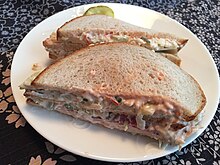 Turkey and pastrami sloppy Joe from Millburn Deli in Millburn, NJ | |
| Course | Main |
|---|---|
| Place of origin | United States |
| Region or state | Northern New Jersey |
| Main ingredients | thin sliced rye bread, sliced meat, Swiss cheese, coleslaw and Russian dressing |
| Variations | Multiple |
Throughout most of northern New Jersey, a sloppy joe is a cold delicatessen sandwich. There are minor variations depending on the deli, but it is always a double-decker thin sliced rye bread sandwich made with one or more types of sliced deli meat, such as turkey, ham, pastrami, corned beef, roast beef, or sliced beef tongue, along with coleslaw, Russian dressing, and sometimes Swiss cheese. [1]
Turkey is considered the standard meat, usually with corned beef and roast beef. Some delis that offer the New Jersey sloppy joe, such as Mr. J's Deli in Cranford, label the ham version as a regular joe. The Millburn Deli in Millburn is a noted sloppy joe maker. [2] [3]
The Town Hall Deli in South Orange claims to have invented the New Jersey sloppy joe in the 1930s. [4] According to the deli's owner, a Maplewood politician, Thomas Sweeney, returned from a vacation in Cuba, where he spent time at a bar named Sloppy Joe's. The bar's owner laid out fixings for patrons, who put sandwiches together. Sweeney asked Town Hall to cater his poker games with the same sort of sandwiches, and they caught on. [3] [5]
In the 1950s, several Jewish delis in Newark and surroundings were also selling the sandwich, including places like Tabatchnicks, Kartzman's, Karpen's Deli in Passaic, and Union Pantry in Union.[ citation needed ]
Mainstream supermarkets in the region, such as Kings, sometimes label sandwiches turkey sloppy joes to distinguish them from the ground beef sandwich of the same name. A similar sandwich referred to as the New York deli turkey sandwich is also found in New York City and the region. It is similar to the Sloppy Joe in that it includes Coleslaw and Russian dressing and usually comes on rye bread. However, it is not normally a double decker and is not usually cut in three wedges.[ citation needed ]